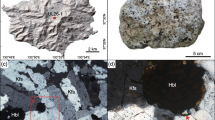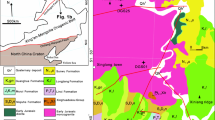Summary
The origin, whether primary (magmatic) or secondary (Ca-metasomatic) after elpidite, of the Ca-rich zirconosilicates armstrongite and gittinsite in the subsolvus granite of the Strange Lake peralkaline complex (Quebec-Labrador border, Canada) has been a well debated topic. These zirconosilicates, along with zircon and amphibole, account for most of the Zr in the associated Zr-, REE-, Y-, Nb-, and Be-rich ore deposit. In this study, cathodoluminescence (CL) examination and transmission electron microscopy (TEM) have been used to shed light on the relationships among and origin of these zirconosilicates. Optical and CL observations indicate that elpidite undergoes epitaxial replacement by armstrongite and, subsequently, by gittinsite. This gittinsite is generally associated with quartz and variable amounts of hematite. TEM results suggest the bulk replacement of elpidite by poorly crystalline armstrongite, followed by gittinsite and quartz, or zircon and quartz. The Ca-rich compositions of elpidite and its structural similarity with armstrongite imply the existence of a solid solution with armstrongite. Moreover, the enrichment of gittinsite in Mn and Fe (and in some cases Y), and armstrongite and zircon in Y, as determined by analytical electron microscopy (AEM), correlates with the presence of these elements in the Ca-metasomatic fluid. These structural and compositional relationships indicate that the primary, magmatic elpidite is replaced by armstrongite and, subsequently, by gittinsite and quartz during Ca metasomatism of the complex.
Résumé
L'origine, primaire (magmatique) ou secondaire après l'elpidite (metasomatose du Ca), des zirconosilicates riches en calcium, soit l'armstrongite et la gittinsite, dans le complexe granitique sub-solvus de Strange Lake (Québec-Labrador, Canada) a fait l'objet de controverses. Ces zirconosilicates, ainsi que le zircon et l'amphibole, contiennent la majeur partie du zirconium présent dans ce complexe qui comprend un gisement important de Zr, Terres-Rares, Y, Nb et Be. Dans cette étude, un examen des relations texturales entres les zirconosilicates par cathodoluminescence (CL) et par microscope électronique en transmission (MET) a été effectué afin de clarifier leur origine. Les observations en optique naturelle et en CL montrent que l'armstrongite et, subséquemment, la gittinsite, se sont formés par remplacement épitaxique de l'elpidite. La gittinsite est généralement accompagnée par du quartz et par des quantités variables d'hématite. Les résultats de la MET suggèrent un remplacement de l'elpidite par de l'armstrongite pauvrement cristallisé, suivi, soit par de 1a gittinsite et du quartz, soit par du zircon et du quartz. La présence d'elpidite riche en Ca et sa structure cristalline similaire a celle de l'armstrongite indique q'il existe une solution solide depuis l'elpidite vers l'armstrongite. De plus, un enrichissement en Mn et en Fe de la gittinsite (parfois aussi en Y), et en Y de l'armstrongite et du zircon, déterminé par analyse au microscope électronique (AEM), est corrélé avec la présence de ces éléments dans un fluide responsable de la métasomatose du Ca. Les relations de structure et de composition entre l'elpidite primaire, magmatique, et l'armstrongite, la gittinsite et le quartz, indiquent que l'elpidite a été remplacée par ces derniers durant un épisode de métasomatose du Ca.
Similar content being viewed by others
References
Birkett TC, Miller RR, Roberts AC, Mariano AN (1992) Zirconium-bearing minerals of the Strange Lake intrusive complex, Quebec-Labrador. Can Mineral 30: 191–205
Cannillo E, Rossi G, Ungaretti L (1973) The crystal structure of elpidite. Am Mineral 58: 106–109
Christophe-Michel-Lévy M (1961) Reproduction artificielle de quelques minéraux riches en zirconium (zircon, eudialyte, catapléite, elpidite); comparaison avec leurs conditions naturelles deformation. Bull Soc Franq Mineral Crystall 84: 265–269
Fiori CE, Swyt CR, Myklebust RL (1994) NIST/NIH Desktop spectrum analyzer program, Version 2.0.1 United States Department of Commerce
Fleet ME, Arima M (1985) Oriented hematite inclusions in sillimanite. Am Mineral 70: 1232–1237
Fleet ME, Bilcox GA, Barnett RL (1980) Oriented magnetite inclusions in pyroxenes from the Grenville Province. Can Mineral 18: 89–99
Herzog LF, Marshall DJ, Babione RF (1970) The luminoscope: a new instrument for studying the electron-stimulate luminescence of terrestrial, extra-terrestrial and synthetic materials under the microscope, In:Weber JN, White E (eds) Space science applications of solid state luminescence phenomena. MRL publication 70-1.01, State College, Pennsylvania, pp 79–98
Kashaev AA, Sapozhnikov AN (1978) Crystal structure of armstrongite. Sov Phys Crystall 23 (5): 539–542 (translated from Kristall 23: 956–961)
Marr RA, Wood SA (1992) Preliminary petrogenetic grids for sodium and calcium zirconosilicate minerals in felsic peralkaline rocks: the SiO2-Na2ZrO3 and SiO2-CaZrO3 pseudobinary system. Am Mineral 77: 810–820
Miller RR (1986) Geology of the Strange Lake alkalic complex and the associated Zr-Y-Be-REE mineralization. Current Research, Newfoundland Dept Mines Energy, Mineral Development Div Rept No 86-1: 11–19
— (1988) Yttrium (Y) and other rare metals (Be, Nb, REE, Ta, Zr) in Labrador. Current Research, Newfoundland Dept Mines Energy, Mineral Development Div Rept No 88-1: 83–91
— (1996) Structural evolution of the Strange lake peralkaline rare-element (NYF) granitic pegmatite, Quebec-Labrador. Can Mineral 34: 349–371
Morgan PED, Hicks JL, Bump HA, Koutsoutis MS (1987) Unit cells and indexed X-ray powder patterns of two calcium zirconium silicates. J Materials Sci Lett 6: 559–561
Pandit SS, Jacob KT (1994) Phase relations in the system CaO-SiO2-ZrO2 at 1573 K. Steel Res 65(10): 410–413
Roelofsen JN (1997) The primary and secondary mafic silicates of two alkaline anorogenic complexes: Strange Lake (Quebec-Labrador) and Amba Dongar (Gujarat, India). Thesis, McGill University, Canada, 534 pp
Roelofsen-Ahl JN, Peterson RC (1989) Gittinsite: a modification of the thortveitite structure. Can Mineral 27: 703–708
Salvi S, Williams-Jones AE (1990) The role of hydrothermal processes in the granite-hosted Zr, Y, REE deposit at Strange Lake, Quebec/Labrador: evidence from fluid inclusions. Geochim Cosmochim Acta 54: 2403–2418
— (1995) Zirconosilicate phase relations in the Strange Lake (Lac Brisson) pluton, Quebec-Labrador, Canada. Am Mineral 80: 1031–1040
Sapozhnikov AN, Kashaev AA (1978) Features of the crystal structure of calcium-containing elpidite. Sov Phys Crystall-23 (1): 24–27 (translated from: Kristall 23: 52–56)
Veblen DR, Bish DL (1988) TEM and X-ray study of orthopyroxene megacrysts: microstructures and crystal chemistry. Am Mineral 73: 677–691
Vladykin NV, Kovalenko VI, Kashayev AA, Sapozhnikov AN, Pisarskaya VA (1973) Armstrongite, a new calcium-zirconium silicate. Dokl Akad Nauk SSSR 209: 124–126 (translated from: Dokl Akad Nauk SSSR 209: 1185–1188)
Zajac IS, Miller RR, Birkett TC, Nantel S (1984) Le gîte de Zr, Y, Nb et Be du complexe alcalin de Strange Lake, Québec-Labrador. Ministère Énergie Ressources Québec DV 84-18: 127–142
Author information
Authors and Affiliations
Rights and permissions
About this article
Cite this article
Roelofsen, J.N., Veblen, D.R. Relationships among zirconosilicates: examination by cathodoluminescence and transmission electron microscopy .. Mineralogy and Petrology 67, 71–84 (1999). https://doi.org/10.1007/BF01165117
Received:
Revised:
Issue Date:
DOI: https://doi.org/10.1007/BF01165117




